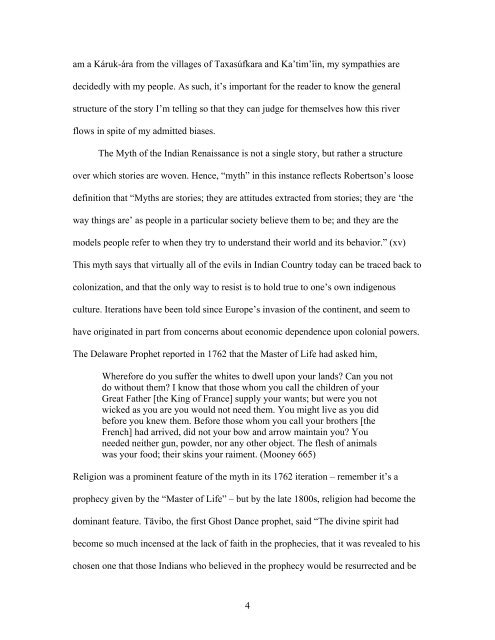The Intersection of Karuk Storytelling and Education
The Intersection of Karuk Storytelling and Education
The Intersection of Karuk Storytelling and Education
You also want an ePaper? Increase the reach of your titles
YUMPU automatically turns print PDFs into web optimized ePapers that Google loves.
am a Káruk-ára from the villages <strong>of</strong> Taxasúfkara <strong>and</strong> Ka’tim’îin, my sympathies are<br />
decidedly with my people. As such, it’s important for the reader to know the general<br />
structure <strong>of</strong> the story I’m telling so that they can judge for themselves how this river<br />
flows in spite <strong>of</strong> my admitted biases.<br />
<strong>The</strong> Myth <strong>of</strong> the Indian Renaissance is not a single story, but rather a structure<br />
over which stories are woven. Hence, “myth” in this instance reflects Robertson’s loose<br />
definition that “Myths are stories; they are attitudes extracted from stories; they are ‘the<br />
way things are’ as people in a particular society believe them to be; <strong>and</strong> they are the<br />
models people refer to when they try to underst<strong>and</strong> their world <strong>and</strong> its behavior.” (xv)<br />
This myth says that virtually all <strong>of</strong> the evils in Indian Country today can be traced back to<br />
colonization, <strong>and</strong> that the only way to resist is to hold true to one’s own indigenous<br />
culture. Iterations have been told since Europe’s invasion <strong>of</strong> the continent, <strong>and</strong> seem to<br />
have originated in part from concerns about economic dependence upon colonial powers.<br />
<strong>The</strong> Delaware Prophet reported in 1762 that the Master <strong>of</strong> Life had asked him,<br />
Wherefore do you suffer the whites to dwell upon your l<strong>and</strong>s? Can you not<br />
do without them? I know that those whom you call the children <strong>of</strong> your<br />
Great Father [the King <strong>of</strong> France] supply your wants; but were you not<br />
wicked as you are you would not need them. You might live as you did<br />
before you knew them. Before those whom you call your brothers [the<br />
French] had arrived, did not your bow <strong>and</strong> arrow maintain you? You<br />
needed neither gun, powder, nor any other object. <strong>The</strong> flesh <strong>of</strong> animals<br />
was your food; their skins your raiment. (Mooney 665)<br />
Religion was a prominent feature <strong>of</strong> the myth in its 1762 iteration – remember it’s a<br />
prophecy given by the “Master <strong>of</strong> Life” – but by the late 1800s, religion had become the<br />
dominant feature. Tävibo, the first Ghost Dance prophet, said “<strong>The</strong> divine spirit had<br />
become so much incensed at the lack <strong>of</strong> faith in the prophecies, that it was revealed to his<br />
chosen one that those Indians who believed in the prophecy would be resurrected <strong>and</strong> be<br />
4
















